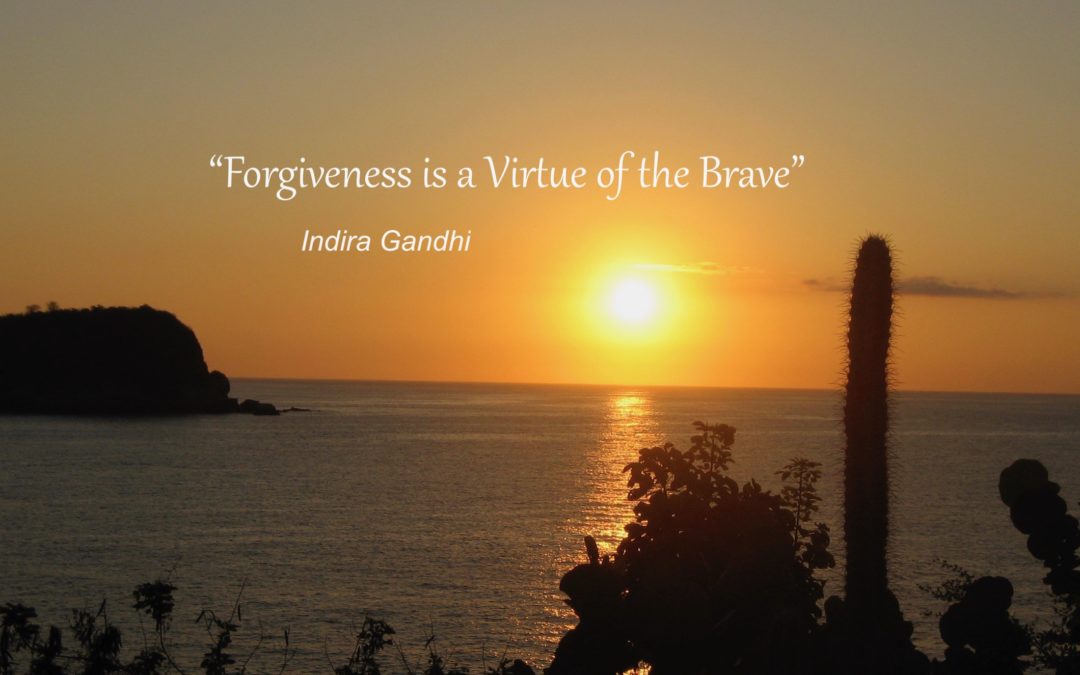
by pam | Jun 11, 2020 | Beliefs & Values, Conflict Resolution, Forgiveness, Peacebuilding
With all of the recent events, protests and discussion around anti-black racism, it is has made me reflect on some valuable lessons I learned from Dr. Vern Redekop[1] while studying at the Canadian Institute for Conflict Resolution in the early 1990s. At that time, Vern was working on his PhD and I was honored to be part of a social experiment he was conducting as part of his dissertation. Vern was researching what would make people who had been discriminated against and harmed on many levels forgive their perpetrators and move forward, as well as increase understanding between the “victim” and the “perpetrator”.
To that end, Vern researched a number of different disciplines and conducted seminars that he invited a mix of people from various backgrounds, cultures, religions and ethnicities to participate in. At the beginning of each seminar he would share the research related to some aspect of the conflict process. Then we were divided into small groups to work on questions Vern provided. Following that we debriefed with the larger group.
There were many participants who shared horrific experiences based on religious, ethnic, and cultural differences. I recall a black man from Rwanda who had seen his family cut up in front of him as part of the genocide that took place in that country. There was an ex-policeman from Northern Ireland who had left the country due to death threats. There was a Sri Lankan woman who had been held hostage by the Khmer Rouge. So many stories and heart-breaking experiences were shared. As well, many of those who shared the horrific acts that had been perpetrated against them, also shared that they had learned to forgive their perpetrators.
There are several things that stand out for me from that experience that I believe can increase our understanding of anti-black racism and other prejudices and horrific acts. One was that in order for “victims” (those who had experienced atrocities and discrimination) to forgive their “perpetrators” (those who had committed the atrocities), the perpetrators had to acknowledge what they had done and issue a formal apology to that person or group. What also was useful in terms of process was for the “victim” or “victims” to sit in a circle with the “perpetrator” or “perpetrators” and for each to share how they were impacted by what had happened. This created increased understanding on both sides and also enabled the “victim(s)” to decide what type of punishment they felt was due to their “perpetrator”. This is how restorative justice is practised (for example among some indigenous communities in Canada) and it is interesting to note that the punishments that are decided upon by the “victim(s)” in a restorative justice process are usually much less harsh than typical sentences arrived at in court.[2]
The other learning that stands out for me was some research Vern shared that demonstrated that the need to belong outweighs many other human needs, and historical events have borne this out. This is important when we think about racism and other forms of prejudice and acts of violence, because it helps us to better understand why people do what they do. It also helps us recognize that it takes a strong and courageous person to step away from a group he/she belongs to and take a stand that is in opposition to that group as they run the risk of being criticized, punished and ostracized.
These two “lessons” from conflict studies and from research on history, human nature and culture I believe are important, particularly at this time when the light is being shone on anti-black racism and other forms of racism worldwide.
Understanding and awareness are important for change to begin. It is also important to understand that there are many layers of belief and cultural conditioning that we need to “peel away” in order to truly forgive, heal and create a better world.
“(A) world free of war and violence;
One where all cultures, (races) and religions are accepted;
Where all people are respected and treated with respect;
Where people live together in communities that model
The values of contribution, collaboration, caring and connection …
One that believes in the power of groups and synergy,
That the whole is greater than the sum of the parts;
A world where women and men stand together as partners.:”[3]
Based on these learnings what actions can we take to move forward and create a better world? I welcome your thoughts and suggestions below.
[1] Professor Emeritus, Conflict Studies, Saint Paul’s University, Founder of the Social Reconciliation, Just Peace and Development Research Group and author of From Violence to Blessing: How an Understanding of Deep-Rooted Conflict Can Open Paths to Reconciliation
[2] “Restorative justice is commonly defined as an approach to justice that focuses on addressing the harm caused by crime while holding the offender responsible for their actions, by providing an opportunity for the parties directly affected by the crime – victims, offenders and communities – to identify and address their needs in the aftermath of a crime. Restorative justice is based on an understanding that crime is a violation of people and relationships. The principles of restorative justice are based on respect, compassion and inclusivity. Restorative justice encourages meaningful engagement and accountability and provides an opportunity for healing, reparation and reintegration. Restorative justice processes take various forms and may take place at all stages of the criminal justice system.” (Source: https://www.justice.gc.ca/eng/cj-jp/rj-jr/index.html)
[3] Excerpted and slightly modified from Learning to Dance with Life: A Guide for High Achieving Women by Pamela Thompson, pp. 153 & 154

by pam | Feb 9, 2020 | Conscious Living, Entrepreneurship, Preventing Burnout, Self-Care, Stress Management, Women in Business
Did you end 2019
feeling exhausted and burnt out? Did you set the intention that this year would
be different, that you would take more time for you and to spend with friends
and family? Are you finding that already you are slipping back into old
patterns of taking work home in the evenings and working on weekends?
I understand. I’ve been there. Early in my childhood I
internalized the belief that in order to be loved and valued I needed to
perform and achieve. And so I kept doing that. Setting one goal, reaching it;
then raising the bar and striving for the next one. Taking very little, if any
time, between my accomplishments to celebrate; until I became exhausted and
burned out.
What happens when we
are driving and striving?
- Our agendas are packed
- We have little or no time for ourselves
- When we are speaking with someone, often half of
our brain is focused on them and the other half is focused on the next thing on
our to-do list
- We feel like there is so much to do and so
little time
- We focus on our goals and become so fixated on
achieving them that we may miss out on other opportunities that come our way
- We often feel tired on awakening
- We may start to feel resentful, as we seem to be
giving to everyone else, yet no one seems to be there to support us when we
need it.
Do you relate? Living this way, constantly driving and striving, leads to adrenal fatigue, burnout, various types of cancer, and auto-immune disorders such as fibromyalgia and multiple sclerosis (for more details on burnout and what to do about it – https://pamela-thompson.com/how-to-know-if-youre-burning-out-what-to-do-about-it/). When we work night and day, our bodies don’t have time to return to homeostasis where we relax and rejuvenate ourselves. As stress hormones constantly surge through us, our organs eventually burn out.
What does thriving
look and feel like?
- We feel happy, healthy and grounded with a balance
between “giving” and “receiving” and “doing” and “being”
- We feel open to possibilities
- We awaken feeling energized and excited about
the day ahead
- We spend time with people we care about
- We feel connected to something greater than
ourselves
- We spend regular time in nature
- We exercise regularly
- We are grateful for the life we have
- We are clear on our core values and live life in
alignment with them.
Feel free to add your own descriptions to the lists above.
How do we move from
driving and striving to thriving?
- We learn to Listen
to and trust in our body’s wisdom – The first step in getting out of our
heads and into our bodies is a mindfulness technique called body scanning. On awakening, you begin
scanning your body from the top of your head to the tips of your toes and
noticing where there is any tension or discomfort. Then you breathe into these
areas and set the intention to release any discomfort. Another mindfulness
practice is mindfulness walking meditations.
I encourage my clients to begin doing this 15 to 20 minutes a day, 3 times
a week. It can be done at noon or during a break. Instead of taking a walk and
thinking about the next thing on your plate or reflecting on a stressful
conversation you had with a partner or team member, you focus on your senses.
You feel the wind on your cheeks, you smell the salt sea air, you hear the
birds singing, you see the beautiful vistas surrounding you. When thoughts come
into your mind you view them as clouds floating by and let them pass, returning
to focusing on one of your senses. When you do this, notice what you notice
during the exercise, after and the cumulative effects.
- When you are feeling stressed, Take deep breaths in through your nose and
out through your mouth; making a sound as you breathe out. When you do this
3 or 4 times you release oxytocin, a hormone that relaxes you.
- Each week
block off in your calendar all of the things you commit to doing for yourself
(that you enjoy). For me one of these is yoga 3 times a week at noon. It
may be going to the gym 3 of 4 times a week after work. It may be meeting a
friend or partner for lunch once a week.
- Set firm
boundaries. Learn to say no. This is important at work, and with family and
friends.
- Notice
your energy levels and schedule your activities to capitalize on these. For
example, if possible, do your creative work when you are naturally more
creative. Schedule meetings after 10 am.
- Spend regular time in nature; walking, hiking, cycling, kayaking … . Nature is therapeutic. Based on several decades of research, the Japanese have evidence to show that forest bathing/walking among trees reduces your heart rate, reduces your blood pressure and increases the number of natural killer cells your body produces. For more on the benefits of being in nature check out: https://pamela-thompson.com/how-you-can-benefit-from-nature-why-its-important/
- Unplug
from technology for at least 24 hours one day a week (e.g. on weekends) if
possible
- Celebrate
your achievements, big and small.
It’s important to reach out for support to friends, family
or a coach, as moving from driving and striving to thriving, IS a journey and
it requires support from others.
For more practical tools and techniques to support you to be healthy, happy and grounded, I invite you to check out my book Learning to Dance with Life: A Guide for High Achieving Women – www.amazon.com/dp/B0145ZGDO2 that is backed up by evidence from neuroscience, eastern psychology and the health promoting and healing benefits of the arts. There is also a series of coaching questions woven throughout the book to support you to move from driving and striving to thriving.
I welcome strategies that you’ve found helpful in the comments below.

by PT-clc | Jan 12, 2020 | Changemaker, Embracing Change, LeadinginUncertainTimes, Women in Business
A new year holds promise and also brings with it
uncertainty.
How do you respond to
uncertainty as a leader and changemaker? Do you typically greet it with
open arms, or hide from it pretending you have all the answers, as you feel
uncomfortable not knowing the outcomes.
What happens when you
approach uncertainty believing you have all the answers? You may set goals
and push through to accomplish them, focusing mainly on the metrics, without
taking into consideration your people and an intervention’s impact on your
organization and its culture. You may miss out on opportunities and creative
solutions that can arise from uncertain situations.
To illustrate what
happens when we greet uncertainty with open arms …
One of the things I’ve enjoyed about working in international health and development is the uncertainty, and with that, the opportunities for new and creative solutions, that present themselves. For example, when I was working in Afghanistan about 10 years ago as a Senior Technical Advisor in Planning and Performance Measurement, I met with the Minister the second day of my 9-month contract. At that time, she shared that although their original plan was to hire a policy and a planning advisor, since I had some experience with policy that she wanted me, within the first month, to give her a report of my impressions of her Ministry’s policy development and planning processes and what recommendations I would offer to improve them. This, on top of the tight timeframe I had to work with her folks to develop the Ministry’s first strategic plan and build their capacity in planning!
I went back to my office and asked the Afghan physician and policy advisor who sat beside me, if he had an org chart of the Ministry in English. He said “no” but he had one in local language. He printed one out for me and I asked him to tell me which departments were in the 15 boxes below the Minister and Deputies and the names of each Director while at the same time writing them all in English on the chart. Then I asked if he would take me to each one of their offices and introduce me to them (a few at a time).
At that time, I shared with each person that I would appreciate the opportunity to meet with them for 1 to 1.5 hours over the next day or so, and asked if there was a time that would work for them. I then followed up with the interview questions by email, which I quickly formulated. Within a month I had interviewed the top 15 department heads, rolled up in a report for the Minister what THEY perceived where the key strengths and weaknesses in their policy development and planning processes, their suggestions for improvement and added my own recommendations. In addition to learning a lot about how policy development, implementation and planning was done at the Ministry, I also had met one-on-one with 15 influential leaders in the organization, which served me well in the coming months.
If I had planned the above scenario in advance, it couldn’t
have worked out better!
What ingredients are
required of leaders and changemakers so we can more effectively deal with
uncertainty and embrace it?
I believe the following are important in this complex and
rapidly changing world we live and work in:
- Authenticity
– Acknowledging that you do not have all the answers or aren’t sure what to do.
- Flexibility
– Creating opportunities to reflect, and the ability to change direction during
a process that has an uncertain outcome (e.g. culture change process) .
- Emotional
Intelligence – Recognizing your own strengths and weaknesses, surrounding
yourself with a team that has complementary skills and personality traits to
yours, inviting their thoughts and suggestions, and truly listening to what
they have to say.
- Process
Understanding and Inclusive Orientation – Valuing a facilitated process
that encourages different voices to be heard and supports diversity.
- Openness
to new ideas – Inviting creative ideas and listening to what people are saying;
(e.g. providing opportunities to encourage people to tap into and express their
creative sides).
- Trust
that everything will work out. Chaos theory has demonstrated that order
comes out chaos.
Uncertainty conjures up fear in many of us; however if we greet it with open arms and include the ingredients above, incredible opportunities and solutions are possible!
How do you embrace uncertainty? I invite your thoughts below.

by PT-clc | Nov 20, 2018 | Benefits of being in nature, Conscious Living, Health & Wellbeing, Self-Care, Stress Management
Introduction to the Experiment
If you’ve been following previous posts you’ll know that I “pressed the pause button” on my business in late June of this year. What I mean by this is I consciously decided to take some time off even though I was healthy, but was feeling a bit tired and uninspired. You may check out this post – https://pamela-thompson.com/creating-space-the-how-and-why/ – to learn more about how I consciously created more space in my life.
I’m excited to share that within the past 2 weeks, I’ve become inspired, feel re-energized and a new direction for my business has surfaced. I’ve realized that I want to integrate elements of my consulting business with my coaching business and to serve heart-centered leaders and changemakers. Stay tuned for more details to come!
The intention of this post is to share the lessons learned from my creating space “experiment”. This past few months have been one of only a couple of times in my life when I have consciously decided to stop working, to spend more time “being” and to focus on “getting out of my head” and “into my body”. Perhaps you relate?
Lessons Learned
One of my friends recently referred to the past 4.5 months as a “fallow” period in my life. A time similar to winter (in the northern hemisphere) when crops and perennial plants go underground and it looks like they are dead and nothing is happening. What really is occurring is that they are in hibernation and things are happening but they aren’t evident. I recently heard that grizzly bears give birth while in hibernation. How cool is that! I feel like even though I wasn’t actively reflecting and wondering what to do next during this period, that things were indeed happening. Similar to a new green shoot pushing itself out of the ground, I feel like the new ideas for my work organically emerged.
So what were the key lessons I learned from this conscious “fallow” period?
- Spending time in nature (almost daily) was an incredible gift. Now if I don’t go for a walk every day to a nearby park or the ocean for at least 20 to 30 minutes, I feel like I need and haven’t gotten my nature “hit”. I don’t feel as energized, joyful and as calm as when I immerse myself in nature daily.
- I now feel more in touch with my body. I’ve changed my diet and have a lot less indigestion than before my “sabbatical”.
- I feel more relaxed and that is a state I can access more easily than before.
- I am more joyful and playful and feel more connected to my “inner child”.
- I feel more present in my conversations with others.
- I feel more sensitive to those around me and have to be careful not to take on their stress or negative energy
- I feel like I’m letting go of some old patterns that no longer serve me; e.g. trying to change someone I care about when they demonstrate unhealthy practices.
- I feel much gratitude for having been able to give myself this gift.
I realize that we can’t all take 4.5 months off every time we’re feeling tired and uninspired. However, I do believe that consciously creating space in our lives is therapeutic, reduces stress and stimulates our creativity, not to mention the positive benefits it has on our relationships.
I’d love to hear from you about strategies you’ve found helpful to create space and if you’ve done something similar to my recent experiment, what you discovered. Feel free to comment below and to share this with others.

by PT-clc | Nov 8, 2018 | Coping with Change, Dealing with Stress, Entrepreneurship, Leadership, LeadinginUncertainTimes, Self-Care, Stress Management
Our world today is characterized by uncertainty. Our economies, our relationships, our jobs, our futures … . Uncertainty is ever present in our lives. Learning how to change your relationship with and to “befriend” uncertainty reduces stress and has a number of other benefits.
The Cambridge English dictionary defines uncertainty as: “a situation in which something is not known, or something that is not known for certain” and “the feeling of not being sure what will happen in the future” (https://dictionary.cambridge.org).
Recently, I came to a point in my business where I was extremely tired and feeling little passion around what I was doing. I knew I needed to make a change but I wasn’t sure what that change was. I had launched a new website and had rebranded less that one year ago. What was I thinking wanting to change things up yet again? Perhaps I just needed to take a break; to relax and “recharge my batteries”?
It was an unusual situation for me to be in, as in the past when I’ve no longer felt “juiced” by what I was doing or felt that an organizational environment was toxic, either I would leave a position, or change my direction in business, and I nearly always knew what I wanted to do next. This recent experience was different. I did NOT know what to do next and felt uncertain.
What happens when we feel uncertain?
We often experience fear and go into fight, flight or freeze – the stress response – as we feel unsafe and our body wants to protect us. When stress hormones are coursing through our bodies we often don’t make rational decisions.
We may “jump” at the first solution that presents itself so we feel more comfortable. This can be a position that we aren’t suited for because we need the money, or a relationship with someone who comes into our life so we won’t be alone.
We may be influenced by a well-meaning friend or person whose opinion we value, and choose a career or position we have the aptitude for; however one that we are not passionate about, instead of taking the time to figure what really “makes our soul sing” and following that path.
I’ve coached a number of clients who were extremely successful accountants, lawyers, engineers … in their late thirties and early forties, who were dragging themselves out of bed every morning, feeling no passion at all for their work. When asked to reflect on when was the last time they felt passion about their work, many admitted that they never really had any passion for their careers; a well-meaning adult had influenced them in their late teens to; for example, “be an accountant because you’re good at Math.”
There was a time in my life when I became a workaholic because I didn’t want to face the uncertainty of what my life might look like if I left my husband. If I kept busy all the time, I didn’t have to think or feel and I numbed out. Possibly you relate.
Uncertainty means different things to different people. I invite you to take a few minutes to think about your responses to the following questions. You may wish to journal about them.
What does uncertainty look and feel like for you?
Do you typically feel fearful when you experience uncertainty? If so, is your typical response fight, flight or freeze?
Do you react differently if the uncertainty is in your personal life than in your professional life?
From experience I know that we often don’t make the best decisions when we feel uncertain. I also know that for those of us who are used to always “doing”, being busy, and having lots of structure in our lives, it can be challenging to NOT DO, but instead to slow down and BE STILL. Many of us believe that to be valued and loved we need to be “doing” and accomplishing important things. Being what I call “in the void” or “in the space between” is quite foreign to us. That said, it can be an interesting journey and valuable experience to learn to feel comfortable with uncertainty.
So how can you change your relationship with “Uncertainty” and perhaps even make it your friend?
Here are some lessons I’ve learned (often the hard way) to “befriend” uncertainty.
- Acknowledge and Accept that you don’t know what to do and that is okay
- Trust that everything will work out for you and the greater good
- Believe that in time things will become clear
- Know that you can’t force clarity
- Remember that creative processes require time and space
- Learn to listen to and trust in your body’s wisdom; it always knows what is best for you.
Below are some strategies to assist in integrating these lessons into your life.
- Learn to listen to and trust in your body’s wisdom. A good place to start is to begin to integrate some mindfulness practices into your life. These practices help take you “out of your head” and “into your body”. They also focus on “being” rather than “doing”. One example is body scanning. On awakening scan your body from the top of your head to the tips of your toes. Notice if there is any tension, discomfort or pain in any part. If you sense any of these breathe into each part and visualize the tension or discomfort releasing or melting away. Another practice is mindfulness walking meditation[1] that I recommend you do three times a week for 15 to 30 minutes each time.
- Spend regular time in nature. This can be going for a walk in a nearby park at lunchtime, hiking, running by the ocean. Finding your special nature place and going there when you feel stressed or would like some guidance.
- Do yoga regularly. Find a style that works for you. I recommend you do it at least three times a week.
- Communicate with others who are close to you. They will then understand how you are feeling and often “cut you some slack”.
- Reach out for support from family, friends, a coach or a health professional.
- Get lots of sleep. If you’re feeling really tired experiment with going to bed earlier.
- Pamper yourself; have a bubble bath, massage, pedicure, make time to read a favourite author
- Move your body. Put on some of your favorite music and dance around your kitchen or living room.
- Connect with your inner child. Do something you used to do as a child that “filled you up” (e.g. painting, drawing journaling) OR try something you’ve always wanted to do but never took the time for (e.g. dancing, learning to play a musical instrument, singing)
- Don’t worry about what anyone else thinks. Remember that when you follow your heart and acknowledge how you feel, you give others permission to do the same.
I’d love to hear from you about your experience with Uncertainty and what strategies and lessons you have found useful to help you deal with it and perhaps even make friends with it. I welcome your comments below.
[1] A mindfulness walking meditation enables you to get out of your head and into your body. When you walk outside in nature, slowly press one heal and the toes of one foot on the ground followed by the next, being totally present with your movements rather than thinking about all you have to do or reviewing a recent argument with your child or significant other. Focus on all of your senses. Notice the wind on your cheek, the sound of birds chirping, the smell of the salt sea air, see the beautiful vistas that surround you. Notice how you feel while doing the mindfulness walking meditations and after. Over time doing these walking meditations on a regular basis, notice what you notice.




